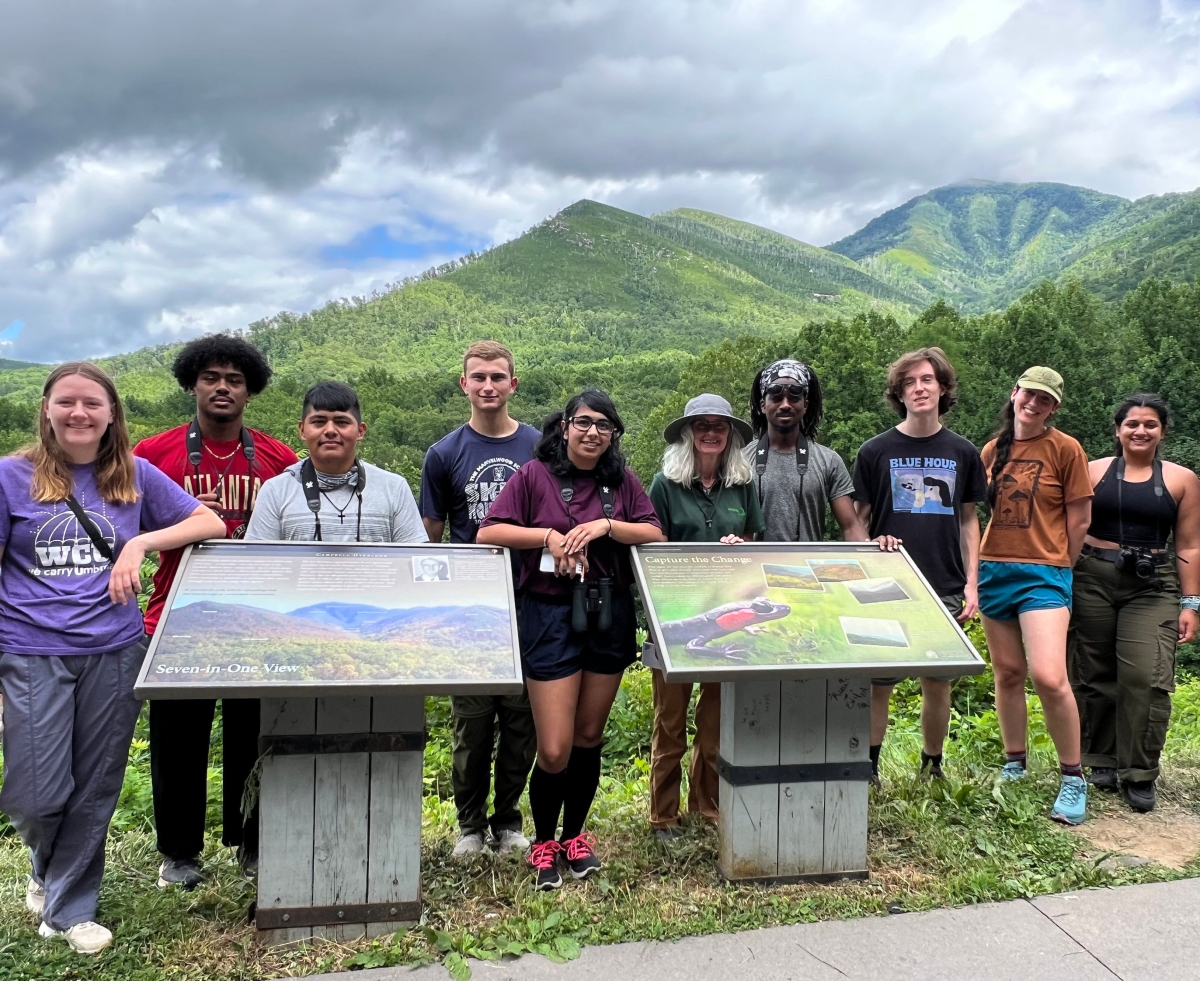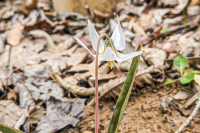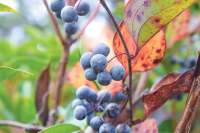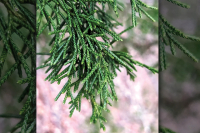Word from the Smokies: Course helps students compare Smokies and tropical ecology
 At Carlos C. Campbell Overlook on the way to Clingmans Dome in Great Smoky Mountains National Park, Deeya Khambhaita and her classmates used scientific instruments to measure altitude (2,000 feet) and temperature (80°F) in much the same way that Alexander von Humboldt, father of environmentalism, would have done.
Travis Knowles photo
At Carlos C. Campbell Overlook on the way to Clingmans Dome in Great Smoky Mountains National Park, Deeya Khambhaita and her classmates used scientific instruments to measure altitude (2,000 feet) and temperature (80°F) in much the same way that Alexander von Humboldt, father of environmentalism, would have done.
Travis Knowles photo
Deeya Khambhaita wasn’t sure what to expect when she signed up for a three-week summer course titled Comparative Temperate–Tropical Ecology and Biogeography. All she knew was it would take her to the Great Smoky Mountains and the rain forest of Ecuador.
“I knew it was going to be immersive and interactive, but I don’t think I fully expected to experience something new every time I took a step out the door,” she said. “The amount of biodiversity we encountered was otherworldly, especially compared to my backyard.”
Deeya grew up in Johnsonville, South Carolina, a “two-traffic-light small rural town where almost everywhere is just woods.” From a young age, she loved being outside and immersed in the natural world. So, it’s no surprise she’s studying environmental science at Francis Marion University (FMU), not far from home. She learned about the Temperate–Tropical course from her freshman-year biology instructor, Professor Travis Knowles.
“I specifically recruited Deeya because she was a star student in the class— meticulous, thorough, and questioning—and I had heard good things about her from other faculty,” Knowles said. “I knew this course would be right up her alley, especially since she had expressed an interest in travel.”
Knowles developed the Temperate–Tropical course with long-time colleague and friend Dr. James T. Costa, a professor of biology at Western Carolina University in Cullowhee. Costa directs Highlands Biological Station in Highlands, North Carolina—where the course began—and Knowles directs Wildsumaco Biological Station in the Napo Province of Ecuador, where students spent the final two weeks of July.
This summer marked the third time the pair of instructors has offered the course, which they describe as “hotspot to hotspot” since both Great Smoky Mountains National Park and the area around Sumaco Volcano in Ecuador are known for exceptional biodiversity. To create the curriculum, they drew heavily on the writings of Alexander von Humboldt (1769–1859), who spent time in both temperate and tropical forests studying the effects of environmental factors such as altitude and temperature on species distribution.
“Humboldt's vision was holistic,” said Costa, “appreciating the interconnectedness of all of nature: organisms, environment, earth—everything. He has been viewed as the father of the modern concept of environmentalism, which encompasses the holistic nature of the natural world, including humanity.”
When Costa first visited Ecuador some years ago, he was following in Humboldt’s footsteps, exploring the “Avenue of the Volcanoes,” which had inspired many of the great scientist’s insights. Starting in Quito in the Inter-Andean Valley, Costa traveled up and over Papallacta Pass in the páramo ecosystem at 13,450 feet and then down the country’s eastern slope through cloud forest to Wildsumaco, a wildlife sanctuary situated at roughly 4,500 feet in “premontane” rain forest.
“I realized that you can really see these Humboldtean ecological–biogeographical principles at work on a grander scale than in the Southern Appalachians, writ large thanks to the height of those mountains compared to ours,” he said. “Elevation and slope have an obvious, profound effect on plant community structure, diversity, and adaptations.”
This got Costa to thinking of other comparative aspects of the temperate zone and the tropics. Here were two mountain systems, vastly different in age, altitude, and ecology, each with a national park and a UNESCO World Heritage Site designation—and with biological field stations close to the same elevation.
“Reflecting on these things with Travis, it didn't take long for us to come up with a novel field-course concept,” he recalled. “I'm not sure there's any other course like it, traveling between field stations in very different ecological–biogeographical settings for direct comparison.”
Their textbook would be "The New Neotropical Companion" by John Kricher, an exhilarating read that draws comparisons between our familiar North American species and those one is likely to encounter in a tropical rain forest. The book explains the latitudinal diversity gradient (LDG), a pattern described by both Humboldt and later naturalists such as Charles Darwin and Alfred Russell Wallace in which “species numbers per unit area tend to decline strongly with latitude as one travels away from the equator.”
During the Smokies portion of the course, the ten students from five universities ventured from their classroom at Highlands Biological Station out into the Nantahala National Forest near Franklin, North Carolina. There they encountered salamanders, one of the few groups in the Smokies with species richness that rivals that of the tropics.
Even more memorable for Deeya, who had never before visited Great Smoky Mountains National Park, was traveling up through the various altitudes and “physically seeing the plant species change as we gained in elevation. To see endemic species like Fraser firs and literally walk through clouds at Clingmans Dome was awe-inspiring.”
As was her instructors’ hope, lessons Deeya learned in South America are already helping her process ecological information about Southern Appalachia.
“One main thing that we learned in Ecuador is the purpose of coloration and morphology in species. Some animals evolved to have bright colors to warn predators that they are unpalatable, called aposematism, or mimic species that are unpalatable,” she explained.
“Other animals evolved to be more sexually dimorphic to attract more mates. The males can display large antlers or generally assert dominance over other males with their appearance to help in mating or display vibrant coloration for courtship,” Deeya continued. “This helped me understand why species here in southeastern North America—like the northern cardinal or eastern tiger swallowtail—look different depending on the sex. These species and many others are all just trying to further their survival.”
She also took away lessons about how climate affects biodiversity in both hotspots. “Seeing the climate change along elevational gradients in both Southern Appalachia and Ecuador and how biodiversity corresponds to that change further cements how disruptive global warming is on our planet,” she said.
Being at Wildsumaco Biological Station and on the surrounding trails was like a continual bioblitz. Hundreds of bird species, moths, butterflies, and insects were seen each day, tamarin and woolly monkeys swung from the trees, and the local hosts brought frogs, worms, and snakes to the station for identification. A plethora of hummingbirds grazed at feeders by day, only to be replaced by a spectrum of neotropical bats at night. And when skies were clear, the Milky Way could be seen stretching across the myriad constellations.
But even sensory overload of this magnitude must occasionally give way to introspection. “The single most important lesson I learned,” said Deeya, “was that I am more capable of things than I previously thought and that I should keep being open to new experiences.”
Her favorite memory is of the students’ last night at the station. They had just taken their final exam and could finally let off some steam.
“The entire evening was spent laughing, cheering, dancing, and just having good old fun,” Deeya said. “I realized that I spend too much time worrying about what will happen in the future and not enough time just being present with the people I’m with. Ever since that night, I’ve been striving to live in the present and take every moment in with gratitude.”
Deeya feels the course helped improve her note taking in the field as well as her ability to work with equipment such as spotting scopes. It also gave her new potential career choices to consider as she heads into her sophomore year.
“I can help animals more if I know more about their environment and what goes into maintaining it,” she said. “Even though I still have much to learn, I feel like this course put me on a better path to achieving my goal of working in conservation.”
Comparative Temperate–Tropical Ecology and Biogeography will be offered again in 2026 and is open to students from any university. Highlands Biological Station of Western Carolina University and Wildsumaco Biological Station of Francis Marion University are committed to the study and protection of biodiversity, and to research and education for students, faculty, and citizens of the United States, Ecuador, and the global community. To learn more or discuss opportunities to visit these stations, contact Jim Costa at This email address is being protected from spambots. You need JavaScript enabled to view it. and Travis Knowles at This email address is being protected from spambots. You need JavaScript enabled to view it..
Frances Figart is the creative services director for the 29,000-member Smokies Life, a partner supporting Great Smoky Mountains National Park by providing educational products and services such as this column. For more information, visit SmokiesLife.org.









